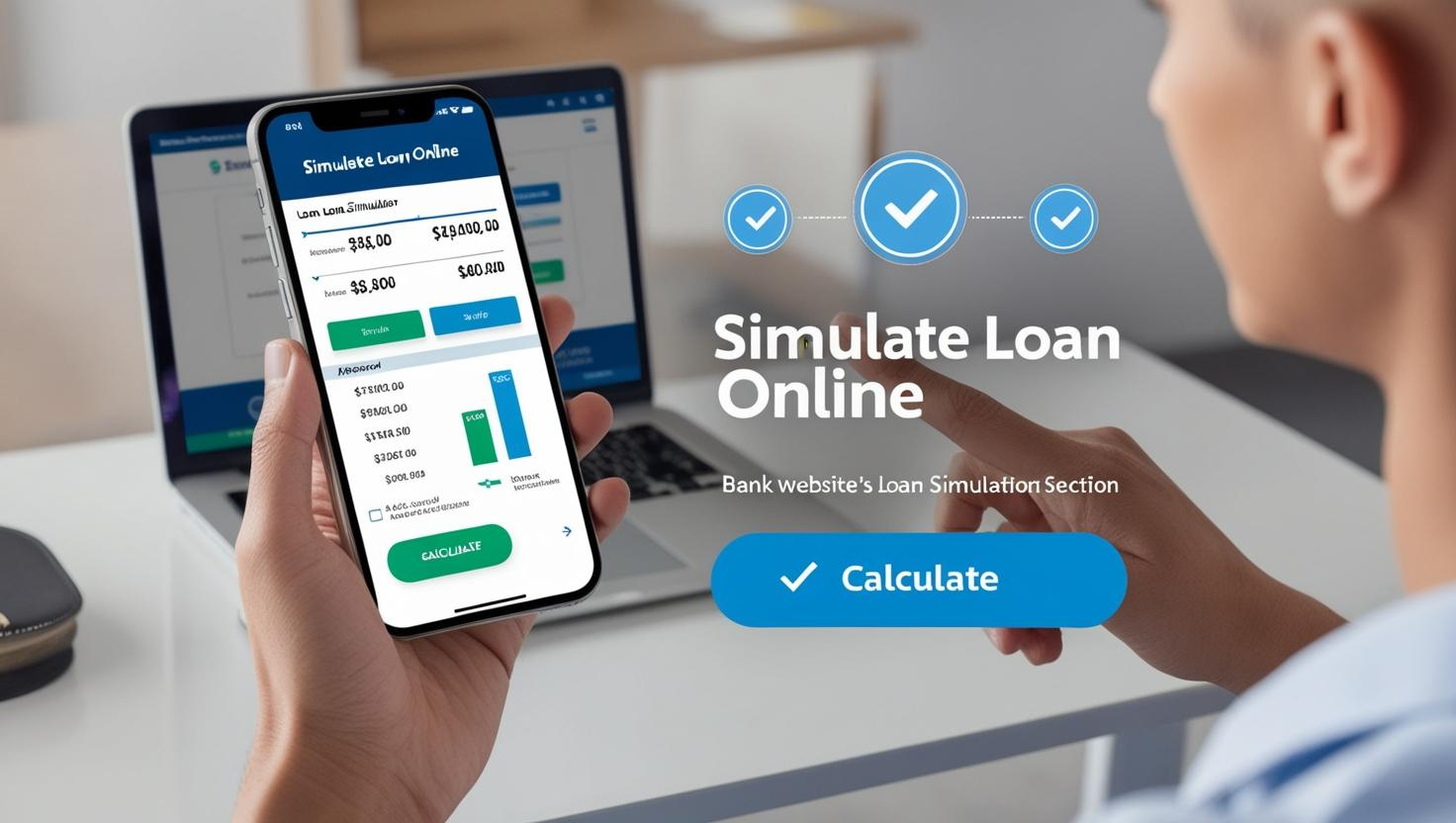Anúncios
Simulating an online loan helps Argentinians quickly identify the installment amounts and fees involved.
Understanding these simulations avoids surprises when taking out credit and ensures safer financial decisions.
We will teach you how to simulate loans in Argentine banks, displaying the necessary documents, detailing the steps, and explaining the benefits. We will also include a comparison between loans in pesos and in dollars, the importance of digital security, and the precautions to take when evaluating interest rates.
Personal Loan
Simulating a personal loan online is the first step to assess real costs, payment conditions, and the feasibility of credit before signing any contract. By accessing bank websites or apps, the applicant enters data such as income, desired amount, and intended term, and in seconds, receives estimates of installments and interest rates. This way, the online loan process becomes transparent and less prone to mistakes, as the system provides approximate values of what will be paid monthly and the total cost over the term.
In Argentina, several factors drive the search for digital simulations. First, the need to compare different institutions without spending time on in-person visits. Second, high competition: public, private banks, and fintechs compete for clients, offering user-friendly interfaces and instant decisions. Third, the growing familiarity of the public with Internet Banking solutions and mobile apps, which simplify the search for financial products. However, it is crucial to keep in mind that a simulation does not equate to the definitive approval of credit; it serves primarily as a projection based on parameters such as salary, credit history, and the bank’s risk policy. If any criteria are not met, the simulated offer may become unfeasible or adjusted in the final rate.
As the applicant becomes familiar with the simulation websites or apps, they can check terms of 6, 12, or 24 months (or more), observing how each change affects the monthly installment. They may also discover that opting for a longer term results in a lower monthly payment, but the total cost tends to increase, and vice versa. In some simulators, it is possible to choose between fixed or variable rates, based on reference indexes (such as rates set by the Central Bank or reference values linked to inflation). The result is a comparative practice: the consumer can, in just a few minutes, analyze 2 or 3 offers and decide which one fits their budget profile best. Below, we will present a list of Argentine banks that offer this tool and explore how their loan simulations work.
Banco Nación, Banco Provincia, Digital Fintechs
Banco Nación
How the Loan Works
Banco Nación is one of the pillars of the Argentine banking system, recognized for its credibility and competitive conditions for clients with different profiles (employees, retirees, self-employed individuals).
In terms of personal loans, the institution offers terms ranging from 12 to 60 months (depending on the amount and risk analysis).
The simulation can be done on Banco Nación’s official website, where the interested person enters the desired amount, term, and approximate income, receiving the monthly installment projection and total cost within seconds.
Requirements
• Identity document (DNI).
• Proof of income (pay slips or tax returns for self-employed individuals).
• A bank account at Banco Nación (facilitates approval, but is not always mandatory).
• Satisfactory credit history (no significant pending issues with credit protection agencies).
Benefits
• As a state-owned bank, the rates can be relatively competitive since there is an interest in stimulating the local economy.
• Offers specific modalities for pensioners or salaried employees who receive their salary at the same bank, simplifying the direct debit process.
• In some cases, Banco Nación offers promotions or partnerships with businesses, allowing for reductions in interest rates or the provision of additional products.
Documents Needed to Simulate
For the simulation, only income information is required (without the need to attach a PDF). However, during the pre-approval process, the digital submission of pay slips may be requested.
The website displays amortization schedules and allows for reconfiguring the term to see how the installment amount changes.
Banco Provincia
How the Loan Works
Especially sought after by residents of the Buenos Aires Province, Banco Provincia offers a simple online simulation system.
The customer accesses the portal, enters the amount (which can reach up to around 1,000 USD equivalent in pesos), and defines how many installments they wish to pay. The simulator then provides a preview of the monthly amount and any applicable charges.
Requirements
As with other banks, DNI, proof of address, and proof of income (pay slip or tax document) are required.
For larger amounts, a bank history may be needed to demonstrate repayment capacity, especially if the installment is significant in relation to the salary.
Self-employed individuals and freelancers present tax declarations (IVA, Ganancias) as proof of income.
Benefits of Simulating an Online Loan
- Quick response: The system provides, in real-time, a forecast of the monthly payment and the term for debt repayment.
- Easy comparison of different scenarios (e.g., 12 months vs. 24 months or 36 months).
- Transparency in CFT: Banco Provincia usually highlights rates and charges at the end of the simulation.
Documents Needed to Simulate
Typically, only income and CPF (or CUIL) information are required in the initial stage.
To proceed with the actual loan process, pay slips or bank statements are submitted digitally through the bank’s platform.
Digital Fintechs
How the Loan Works
Unlike traditional banks, fintechs use 100% digital platforms and fast risk-analysis algorithms.
The applicant downloads the app or visits the website, enters personal data (DNI, email, phone number), and provides estimated income. The simulation and approval can take place in minutes, with minimal bureaucracy.
Requirements
- Be of legal age, have residency, and a bank account in Argentina to receive the deposit.
- In some cases, fintechs may perform a superficial credit history check but promise to serve even profiles with restrictions.
- Regardless, the payment capacity and minimum income stability are verified.
Benefits
- Simplified Approval: No bureaucracy, based on algorithms and minimal document requirements.
- Speed of Disbursement: The common promise is “money in your account in minutes or hours,” overcoming the delays of many banks.
- Caution with Rates: However, it’s important to note that the flexibility and speed can translate into relatively high interest rates, compensating for the risk taken by the fintech.
Documents Needed to Simulate
Frequently, no documents are attached in the simulation process—just data and authorizations for the app to access records or check bank statements.
Once the verification is completed, the fintech provides the interest rate and final installment details.

How to Calculate Installments in the Simulation
When the system displays the monthly installment, it applies an amortization formula, determining the amount due each month until the end of the term. In Argentine banks, the most common method is the French system, where the installments remain fixed (if the interest rate is fixed), but the composition of interest and amortization changes over time.
Step-by-Step to Simulate the Installments
1. Choose the Amount and Term
Let’s say you need 200,000 pesos and plan to pay it off in 24 months. In the simulator, enter “200,000” as the amount and “24” as the number of installments.
2. Select the Rate (Fixed or Variable)
If the rate is fixed at 45% per year, the website will automatically convert it to an effective monthly rate and calculate the corresponding installment.
3. Check the CFT
Before confirming, the simulator typically adds the cost of insurance and commissions, returning the exact value of the final installment, for example, 15,000 pesos per month.
4. Analyze If It Fits Your Budget
By multiplying 15,000 pesos by 24, the total comes to 360,000 pesos, indicating that there will be 160,000 pesos in interest and charges. If this is feasible and you accept these conditions, proceed with the request.
5. Compare with Other Scenarios
Try 18 months or 36 months to observe the variation in installments and the total cost. Sometimes, extending the term reduces the monthly installment but increases the total accumulated interest.
Comparing Loans in Dollars or Pesos
In the Argentine context, some banks offer loans tied to the dollar, while most conduct transactions in pesos. Understanding the difference is crucial:
Loan in Pesos
This is more common and is influenced by domestic inflation, but the installment tends to be predictable if the rate is fixed. If inflation rises, the rate may update in indexed or UVA contracts, but there is also the possibility of a fixed rate until the end of the term.
Loan in Dollars
Some banks offer the possibility of dollar-denominated credit, which requires the borrower to have income or guarantees in dollars as well. The risk is currency fluctuation: if the peso depreciates, the dollar debt becomes more expensive in pesos. On the other hand, if the borrower earns or profits in dollars, this can be advantageous.
Factors to Consider
If you earn in pesos and don’t have a hedge against currency fluctuation, the risk of getting into dollar debt can be significant. Conversely, those who earn in dollars (exporters, international freelancers) may find a dollarized loan with lower interest rates beneficial, but with exchange rate volatility.
It can be concluded that the decision depends on income flow and the level of risk one is willing to take. The online simulation should clearly show the rate and the repayment method (pesos or dollars) to avoid long-term setbacks.
Is It Necessary to Prove Income or Have a High Credit Score to Simulate?
Simulating a loan does not necessarily require a high credit score or formal income verification. Typically, the online simulation only asks for estimated data, such as your salary or monthly income, to generate an installment forecast. However, for the actual loan approval, the bank or fintech will conduct a real verification, asking for pay slips, tax declarations (for self-employed individuals), and checking credit bureaus that evaluate your payment history.
Simulation:
The system accepts any amount entered, but if the value is unrealistic for the customer, the final offer may be rejected or adjusted when the institution verifies the data.
Approval:
Once the documentation is submitted, if the score is below the desirable threshold or if the income is insufficient to cover the installments, the request may be denied, or the granted amount may be lower than the simulated amount. Fintechs usually require a lower score, but they compensate with higher interest rates.
Tip:
If your score is not very high, look for banks where you already have a salary account or a prior relationship, as they are more likely to approve loans with more flexibility, knowing your profile.
In summary, the simulation is free and does not guarantee anything, but it serves as a guide to know what to expect regarding the total cost. The ideal is to avoid overestimating your income or getting fooled by very high amounts that may not be approved.
Summary of Benefits
- Convenience: Simulating online saves time, without the need to visit multiple agencies.
- Quick Comparison: In minutes, you can compare rates, terms, and amounts from various Argentine institutions.
- Transparency: The simulation displays the CFT, preventing surprises from hidden charges and commissions.
- Early Approval: Some banks indicate if there’s a pre-approval during the simulation, speeding up the process.
- Installment Adjustment: The customer can adjust the term and amount, aligning the installment with their actual budget.
- Reliability: Official banks and fintechs ensure the legitimacy of the simulation, showing real conditions.
- Speed of Hiring: Once the simulation is complete and the offer is accepted, approval can happen within hours.
- Better Financial Literacy: Understanding interest rates and calculations helps consumers make informed decisions.
Updated Frequently Asked Questions
1. Can the online simulation be different from the amount I actually receive at the end?
In general, the simulation provides an estimate. The final approval may modify rates or amounts if, upon analyzing the history, the bank perceives higher risk or if the customer’s income is lower than what was initially provided.
2. If I don’t have an account with the bank, but I do the simulation, do I need to open an account to receive the money?
In most traditional banks, yes, you need to have a checking account for the deposit. In fintechs, however, you only need to provide a valid CBU (bank account). If the account is with another bank, there may be a slight delay in the transfer.
3. Does the simulation on the bank’s app or website check my credit score right away?
In many cases, a superficial check is done, but the deep check occurs at the approval stage. The simulation may not reflect any restrictions if the system hasn’t yet accessed your detailed credit history.
4. Can I do multiple simulations at different banks without harming my credit history?
Simulating by itself doesn’t generate formal credit bureau inquiries. The inquiry that impacts your score happens when you officially request the loan. So, it is safe to compare previous simulations.
5. How can I tell if the website simulating the loan is trustworthy or not a scam?
Check the website address (to ensure it is official from the institution). Make sure there is a secure connection (HTTPS) and that the bank or fintech’s brand matches what is shown through official channels. For extra security, access the site through Google or links from the bank’s main website, avoiding clicks from suspicious SMS messages.
Simulating a loan online is an essential practice in Argentina for anyone who wants to evaluate the cost, term, and feasibility of obtaining personal credit. Thanks to digital platforms from banks like Banco Nación and Banco Provincia, as well as innovative fintechs, it is possible to estimate the installments in just a few clicks, allowing the consumer to assess whether the installment amount fits their budget and if the rates applied are competitive in the market. This process not only saves time—eliminating the need for in-person visits—but also reduces the risk of future surprises by clearly showing the total financial cost.
Despite the simplicity, certain precautions are essential. First, it’s important to distinguish between simulation and approval: the simulation shows hypothetical values and doesn’t guarantee that the bank will confirm the exact rate. Documentation and credit history verification (credit score) may lead to slightly different final conditions. Additionally, economic changes and inflation in Argentina can cause banks to update their rates frequently, meaning a simulation done in January might already be outdated a few months later. Therefore, it is always advisable to perform the simulation as close as possible to the time you intend to apply for the loan.
Another important point is comparing options in pesos versus dollars. On the one hand, credit in pesos is more common but can be influenced by indexed rates; on the other hand, a dollarized loan involves currency risks that could lead to surprises if the peso suddenly depreciates. Finally, ensuring the security of information during the online simulation process should be a priority, by choosing official channels and avoiding sharing data on dubious websites. With this set of practices, online simulation becomes a valuable tool, allowing Argentine consumers to manage their finances responsibly and choose the credit most suited to their goals.



